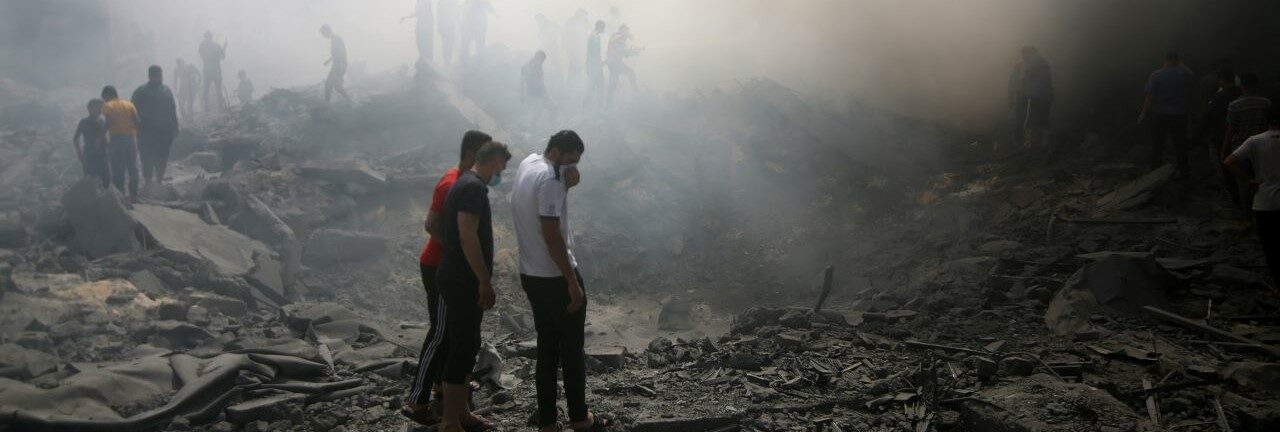Israel’s Nuclear Assets and Hamas Threat
THE TRIBUNE
APLN member C. Uday Bhaskar argued that the Gaza experience suggests that there is a case for introducing nuclear-related guardrails and red lines even for non-state entities and their state sponsors. Read the original article here.
ThE war in Gaza, triggered by the Hamas terror attack that caught Israel by surprise on October 7, has entered its third month, with no sign of any meaningful cessation of the reprisal attacks by the Israel Defence Forces (IDF). The UN Secretary-General, Antonio Guterres, has invoked the rarely used Article 99, but it is uncertain whether this will have any substantive impact sans US support.
Many lessons about asymmetric warfare will be drawn by domain experts across the world in relation to the efficacy of the Hamas rocket attacks and the surprise element achieved by a non-state entity against an adversary deemed to be a formidable and highly militarised state. However, one strand that merits attention is an embedded nuclear dimension.
The first intemperate N-reference was made by Israel’s Heritage Minister Amichai Eliyahu in a radio interview on November 5, when he declared that using a nuclear weapon on Gaza is “an option” in the IDF’s current war on Hamas. This assertion was swiftly denounced and rejected by Israeli PM Benjamin Netanyahu, but the threat had been made, thereby muddying the deterrence domain. This statement by the Israeli minister led to a rebuke by most major powers and the matter seemed to be buried — but only for a brief period.
An investigative report by The New York Times (December 4) revealed that “a rocket launched from Gaza on October 7 hit an Israeli military base believed to house nuclear-capable missiles, although it’s likely they were not in danger”.
It is instructive that the first disclosure about such an attack on a nuclear facility emerged from a major US publication, and the IDF, which has enabled scores of global media personnel to report on the war in Gaza, has remained tight-lipped about this incident.
The New York Times’ team analysed publicly available satellite imagery, rocket alarm data and social media posts to piece together its report. The central inference is that the Sdot Micha military base in central Israel (40 km north-east of Gaza), which is believed to house Jericho nuclear-capable missiles, was attacked by Hamas rockets on October 7. However, the report adds that there was no damage to the missiles themselves, though the impact of the rockets “sparked a fire that approached missile storage facilities and other sensitive weaponry”.
Israel’s nuclear weapon capability has been deliberately cocooned in opacity. The received wisdom is that the Jewish state acquired this apocalyptic capability in a covert fashion in the late 1960s and that the US and its allies had either tacitly enabled this WMD (weapon of mass destruction) status or turned a blind eye to it when Israel engaged in clandestine activities.
Israel is deemed to be a de facto nuclear weapon state and is a non-signatory to the Nuclear Non-Proliferation Treaty (NPT), like India and Pakistan. For the record, Israel is the second Asian nation to acquire the N-weapon status after China did so in 1964.
The West Asian region and Israel’s Arab neighbours are more than aware about this nuclear capability in their midst, with the traditional adversary being the Jewish state. While details of the location of these WMD assets (both missiles and fissile material) understandably remain secret, Israel’s small geography allows for reasonably informed conjecture.
The question is: did Hamas target the Sdot Micha base despite its WMD relevance or was this an inadvertent mass rocket barrage that reached random targets in central Israel? Despite the fact that a week has elapsed since the publication of the NYT report, there has been no further reportage — either from within Israel or the global media.
The report does add that Hamas usually targets Israeli cities rather than military bases, and in that sense this attack on the Sdot Micha base is a departure from the norm. On current evidence, it would appear that this Hamas rocket burst may have been a random attack, for it is unlikely that any terrorist group would target a proximate nuclear facility in this manner.
However, in the current fog of war surrounding the violence in Gaza, the other exigency also merits a close look — that Hamas acted in a premeditated manner to degrade Israel’s WMD credibility by targeting a missile base. This scenario is fraught with grave consequences, for if a nuclear facility is targeted by a non-state entity, the worst-case possibility envisioned by security professionals in the aftermath of the September 11, 2001, attacks could have a higher probability of occurrence in the near future.
The more lethal terror groups are perceived to have covert state support, and in the present case, the Hamas-Iran link is a cause for deep concern both for the US and nations in West Asia. Given the critical nature of the nuclear domain, whether due to an inadvertent accident or a pre-meditated attack, the potential consequences of any radioactive fallout must be pre-empted. There is a compelling case to delve deep into the Sdot Micha attack and arrive at an objective and factual account of the causal factors.
The nuclear deterrence theory and practice that had a certain clarity in the bipolar context of the Cold War, when there were only two principal players, have now become complex and opaque, with both state and non-state entities as interlocutors. Outlandish as it may seem, the Gaza experience suggests that there is a case for introducing nuclear-related guardrails and red lines even for non-state entities and their state sponsors. A major power consensus is imperative to evolve an appropriate carrot-and-stick policy to contain this shadowy threat. The global nuclear status quo has been rocked by the wars in Ukraine and Gaza, and this augurs ill for the world at a time when credible global leadership is conspicuous by its absence.
Image: The war in Gaza has entered its third month, with no cessation of IDF reprisal attacks. AP/PTI




